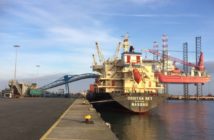AF’s latest AgInflation Index report has revealed the cost of farming inputs has increased by 4.54% in the six months up to February 2018.
This was driven by a 16.9% rise in fertiliser costs, 6.5% in fuel, and 4.8% in animal feed. It is the second report in a row to record an inflation increase of more than 4.5%.
All product areas saw price increases, with cereal and oilseed rape operations hit by 5.75% inflation. With the retail price index at 2% in the same period, the latest Index once again shows farm costs rising faster than those of the consumer.
AF Group chief executive Officer Jon Duffy said: “Our figures once again highlight volatility within the marketplace, underpinned by weak performance of sterling against other major currencies and global supply-chain issues.
“This highlights the need for farmers to get to grips with risk management and to control the controllables. Getting on top of costs is normally a good place to start.
“AF can provide forward fixing, deferred payment and planned purchasing, all of which helps members manage risk effectively and efficiently – offering them resilience against the pressures of what continues to be a challenging market.”
This is the second successive AgInflation Index that has seen the costs of fertiliser grow. There was an 8.9% increase in the year to September 2017, with the price of phosphate and potash influencing a 16.9% rise this time around.
AF Fertiliser and Seed general manager Chris Haydock said: “Year-on-year prices remain unchanged for ammonium nitrate, with the early buyer once again seeing the benefit. While the February price is up considerably on the new-season price, on the back of our advice we have seen more farmers buy earlier in the season than previous years to secure better prices. The real change year-on-year has been the phosphate and potash market where we have seen a £15/t rise, with the outlook being for these prices to remain firm.”
The weakness of sterling against the dollar and unrelenting US shale oil production has seen a 6.5% rise in the cost of fuel – and the market is expected to remain volatile throughout 2018.
AF Fuel trading manager Spencer Hill said: “The International Energy Agency has forecast that global demand for oil is likely to be greater than production in 2018. It does not expect OPEC to change its supply policy, despite there being internal disagreements on where prices should be – with Saudi Arabia wanting to see prices at $70/bbl or higher and Iran wanting to see prices around $60/bbl.”
The 4.8% rise in the cost of animal feed was driven by adverse weather in South America, the closure of a major animal feed production facility in the UK, and a fire at a Citral plant in Germany that took out 40% of the EU’s capacity to manufacture Vitamins A and E.
AF Livestock business development manager Thomas Baines-Sizeland said: “The closure of Vivergo’s Hull plant at the end of 2017 made wheat distillers unavailable and, although alternatives were offered at inflated prices, the required volume wasn’t there. As well as increasing raw material costs, mineral prices rocketed following the BASF factory fire at the end of October. As a result, £2/t– £9/t has been added on to ruminant and monogastric compounds.”




